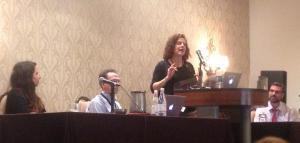By Aaron Sidder
Convening in a chilly air-conditioned ballroom, a panel of four journalists described their experiences writing about the sordid side of science. Organized and moderated by Brooke Borel, a freelance journalist and author, the "Investigative reporting: Uncovering the seedy side of science" session touched on misconduct, harassment, and corruption in science.

Katherine Eban discusses her investigation of Ranbaxy and drug manufacturing. Seated, from left to right: Azeen Ghorayshi, Charles Piller, and John Tedesco; photo by Aaron Sidder
As the panelists spoke, a common thread of advice emerged from their presentations: Be persistent, be diligent, and document everything. All of the presenters emphasized the importance of corroborating every point in a story; it must be bulletproof before publication. To make a story bulletproof, Tedesco recommended thinking like a scientist: Be skeptical and double-check the material, he said. Tedesco also suggested recording everything. Recordings can protect the writer if anyone challenges a quote, and recordings offer hard evidence of lies.
The panelists all commented on the importance of finding sources and cultivating comfortable relationships with them. Sources risk their jobs and livelihoods to speak with journalists, Piller said, and as they emerge they must be handled carefully. Reporters may need to cast a wide net to find sources, and should aim to balance named and unnamed sources in the story. The subject’s personal relationships may create a balance of fairness, Piller said, and will lend the story credibility. In cases where whistle blowers or accusers may be young or junior scientists, Ghorayshi recommended enlisting an older mentor who can facilitate the relationship. These mentors may be more secure in their careers and willing to help expose the problem.
Investigative exposés require more sources than standard science stories, and it may take a long time to find people willing to talk. This takes patience and persistence, but may be aided by LinkedIn. Piller stated he could not have done his story without LinkedIn, and Eban explained that the social media site offers a journalism tutorial that grants users a free upgrade for a year upon completion. The upgrade allows users to send InMail directly, which can help circumvent personal or professional channels that may make the source uncomfortable.
Seedy science does not look like "Breaking Bad" — as Eban jokingly alluded to in her talk — but involves misdeeds of powerful people with much to lose. The goal is to get to the edge of the cliff where the view is best — but be careful not to fall!
More information is available on Twitter using the hashtag #scinvestigate, including Eban’s reporting tools slide. Tedesco's presentation is available at bit.ly/journotips2016.



